Let’s get one thing straight from the start: the Aero System from bikepacking experts Apidura is not made for carrying all your belongings on a multi-day epic. It might look like a frame bag and a top tube bag, but its raison d’être is not cargo hauling.
Instead, as the name rather strongly suggests, the bags are designed to give an aerodynamic advantage to your gravel bike. If this sounds slightly unnecessary for a genre of cycling that is more about enjoying the scenery and exploring traffic-free trails, then you haven’t been keeping abreast of the latest trends and results.
For many of us, gravel riding is about the view, not the speed
(Image credit: Andy Jones)
Gravel riding has a distinct split in it between the aforementioned recreational riders and the more serious gravel racers. With pro riders and some very serious machinery now involved, gravel races are completed in mind-bending times and at warp speed. Cameron Jones completed the 200km 2025 Unbound course at an average of 37.8kph (23.5mph). At those kinds of speeds, aero matters, and Apidura claims a 5W saving from using their system.
Whether it is relevant to you or me is a different matter.
Construction
The combination of frame bag and top tube bag together can only carry 2.2 litres or 3.2 litres of cargo, so not a whole lot. And you purchase the bag that is the right size for your frame, NOT the capacity you would like. There is an online Frame Pack Sizing Tool on Apidura’s website to help you get the right size; it suggested that for my size 56cm Cannondale Topstone, I would need the smaller system.
Or, as Apidura puts it: ‘The Aero System is designed to integrate with your bike to deliver an aerodynamic benefit. As such, the available sizes relate not to the capacity, but to the size of bike that is best suited to deliver this benefit.’
The small top tub bag is a mere 6cm tall and 22cm long, although 3 of those centimetres make up the ‘fairing’. These connected flaps are designed to be pushed forward snug against the headset to smooth out the airflow behind the stem, but don’t attach to the stem in any way.
Access and closure are via a lengthwise magnetic slot designed to be opened with one hand. The bottom of the bag is made from a bright yellow material so that the contents are more visible.
The underside has a silicone gripper pattern on it, as do the two Hypalon straps, for greater security on the frame.
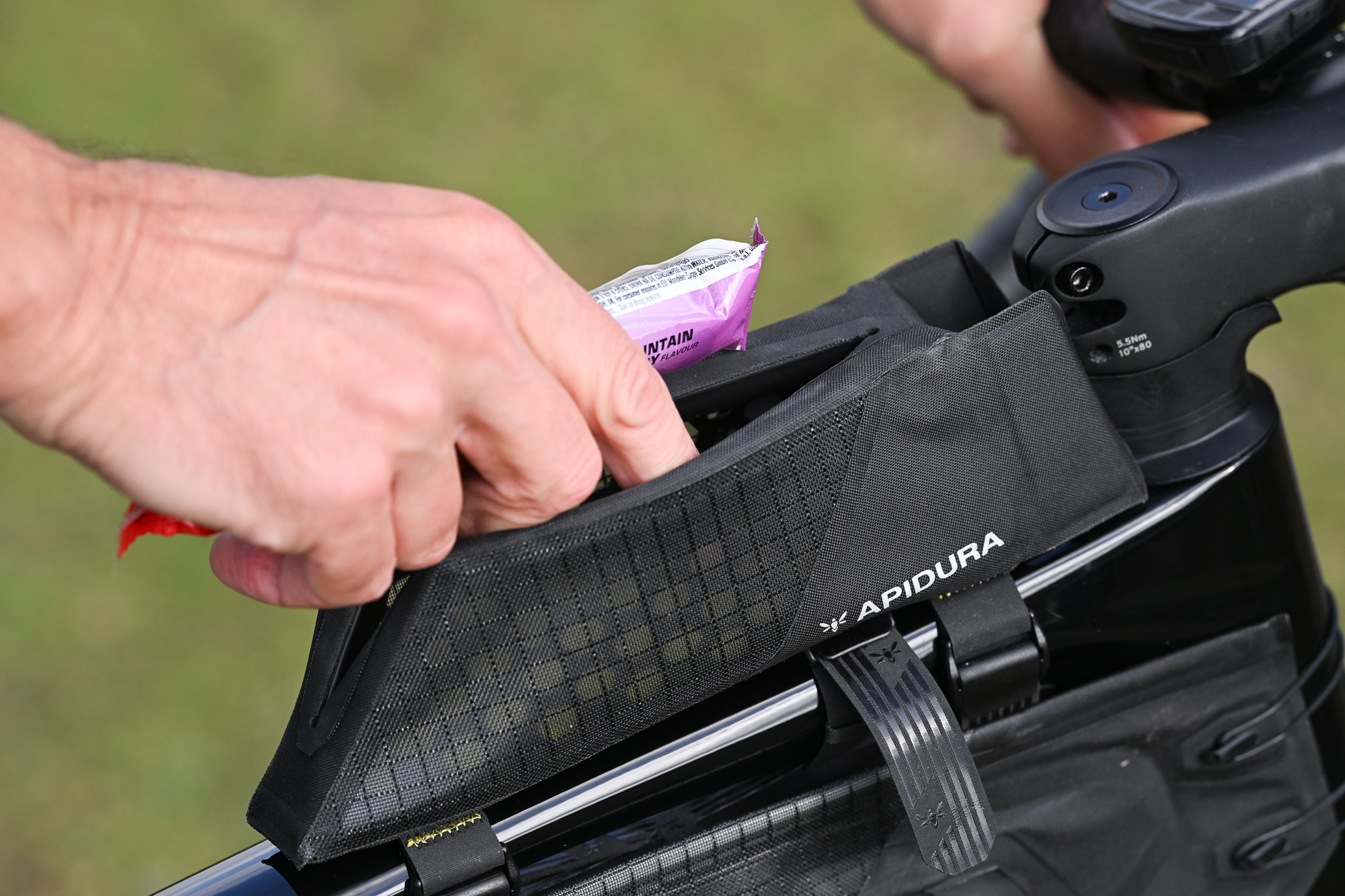
The top tube bag is designed for easy access to snacks
(Image credit: Andy Jones)
The larger frame bag has the same style of straps with silicone grippers and more silicone on the bag’s top side, where it contacts the underside of the top tube. A small lip smooths this junction with the top tube whilst two larger flanges wrap around the sides of the head tube and are secured with two elastic bands – hence the need for an exact fit. These flanges extend down the junction with the down tube, where there is a Velcro strap.
A single waterproof zip on the right-hand side gives access to the bag’s contents, whilst a small, front-facing slot allows a cable to be run out of the bag to a light or computer. Inside, there is a Velcro strap at the front of the bag, which I think is for securing a charging bank, as it’s situated under the egress slot.
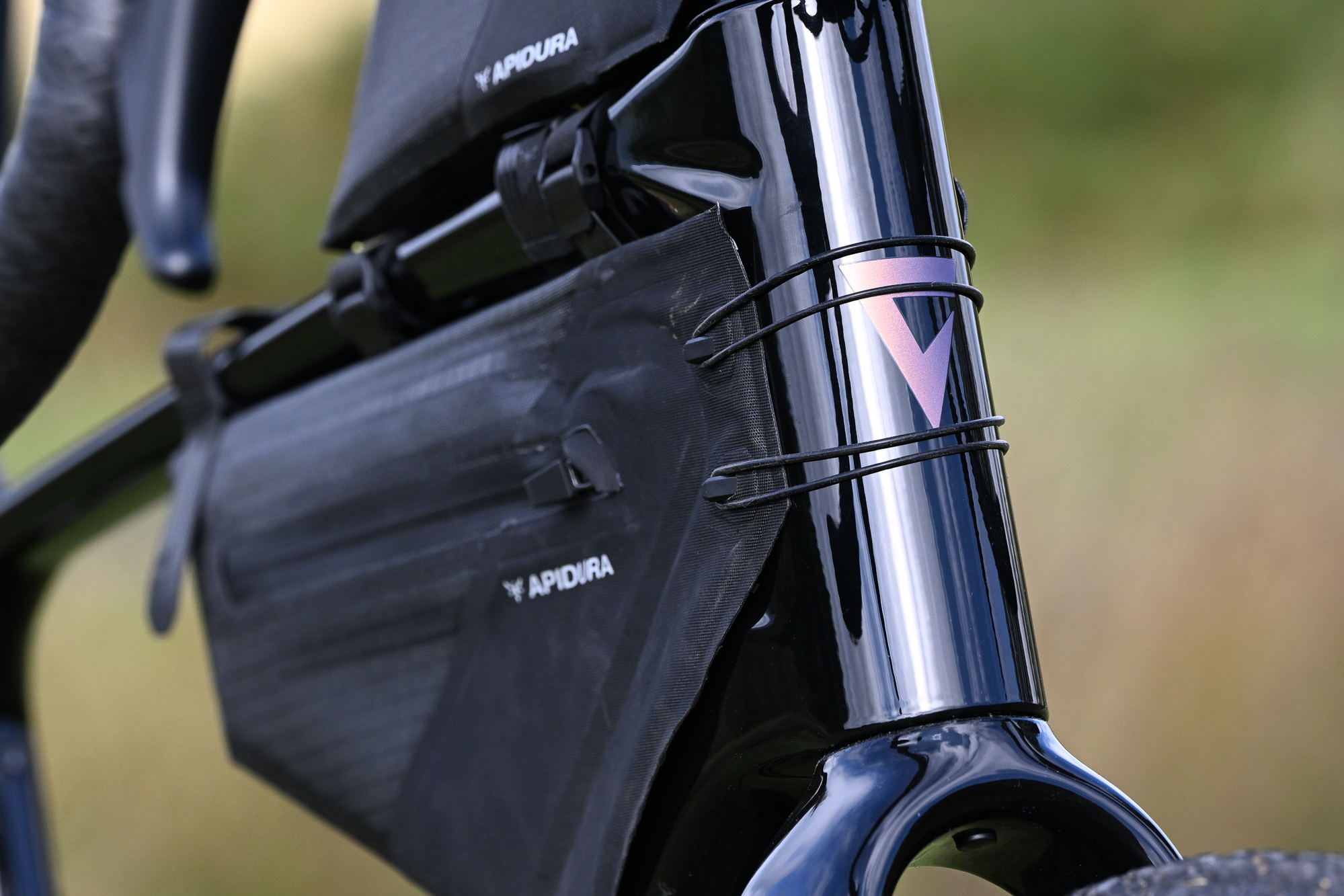
Flaps and flanges integrate the bag to the frame for smoother airflow
(Image credit: Andy Jones)
Both bags are made from the same, very tough-looking black, ripstop fabric supported by an internal ‘HDPE thermoplastic frame’. The upshot of this is that the bags are very rigid, whether full or empty.
Apidura claims that the S/M system weighs 305 grams and the L/XL 335g. My S/M weighed in at 301g.
The ride
On the inside of the box, there are quite detailed instructions as to how to fit the bags, so that they integrate with each other and the frame in the best possible way, and once secured, they do look pretty sleek. However, they work best on bikes with internal cabling; my Cannondale Topstone has cables which enter the frame near the top of the down tube, and this interfered with the flush fit of the bags. They worked much better on the Standert Pfadfinder and Giant Revolt that I also used them on.
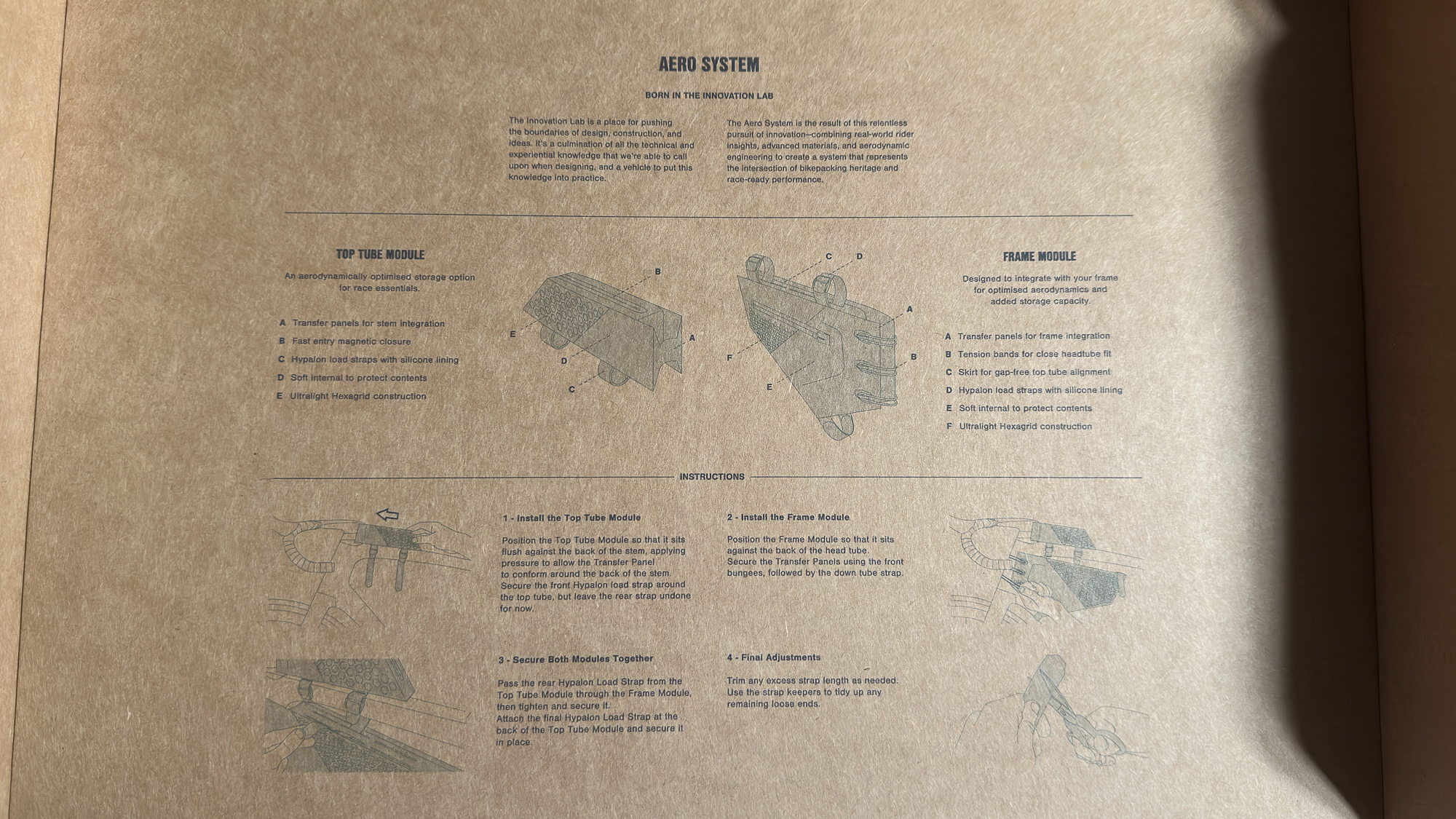
(Image credit: Tim Russon)
Clearly, the aim is to circumvent the UCI regulations regarding frame and tube dimensions by effectively filling in the gaps behind the stem and head tube to reduce drag. At this point, I, and most other recreational gravel riders, should put our hands up and say ‘fair enough, but that is not something I need or want’.
However, having spent some time with the bags, I think that they have other worthwhile benefits too, so even if you are not all about the watts, the Aero System might still be for you.
The primary advantage of the system over many other top tube and frame bags is their stability. Considering that the top tube bag isn’t attached to the stem, it was absolutely rock solid and didn’t sag to either side. Similarly, the down tube bag didn’t sway or bulge either, meaning that there was no danger of my catching my knees on them.
In part, this is due to the rigidity of the construction, and in part due to the excellent grip of the silicone coating on the straps and contact points.
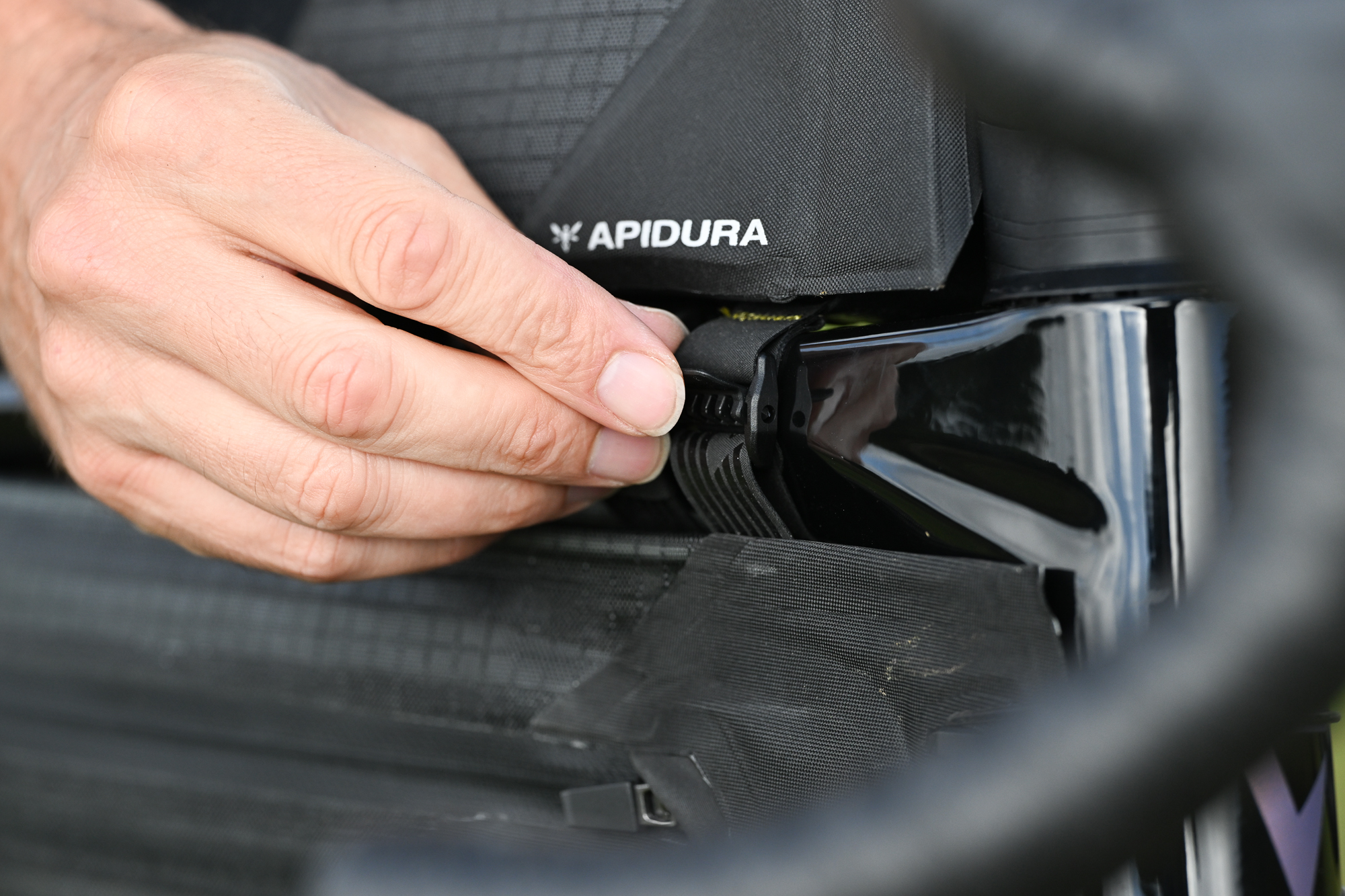
Silicone grippers on the straps and bags keep them stable on the bike
(Image credit: Andy Jones)
The downside to this construction is that, coupled with their diminutive capacity, they were not particularly easy to pack. The combination of stiffness, short, waterproof zip and small size made the frame bag a little awkward to use fully.
I used the bags on a two-day trip around the Yorkshire Wolds, carrying minimal kit in the bags and a larger saddle bag. They were fine, but I just carried a few snacks in the top tube bag and put my waterproof, arm warmers, gilet and multi-tool in the frame bag, leaving the saddle bag to do most of the heavy lifting.
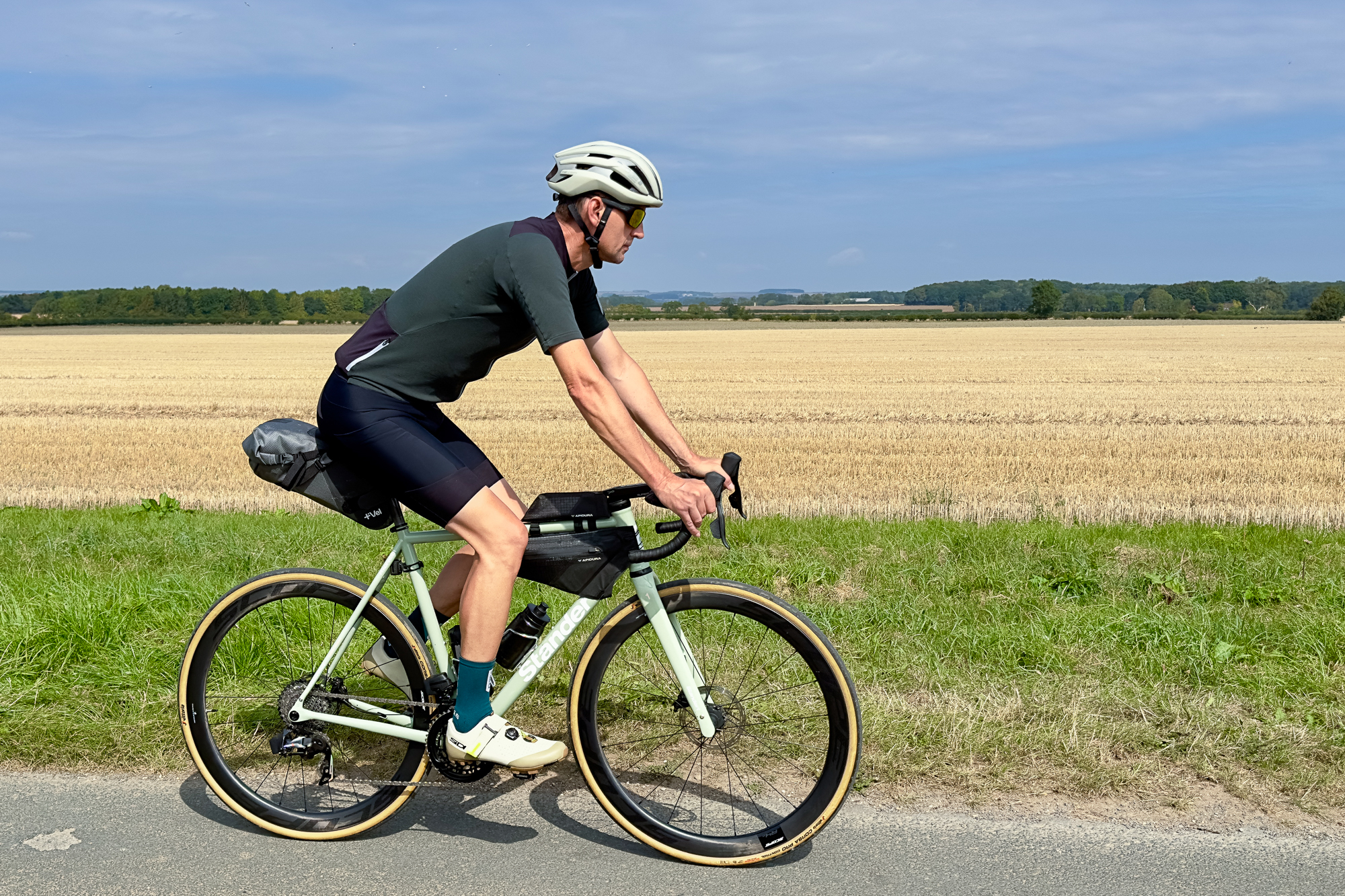
There isn’t much room for bikepacking kit in the Apidura Aero System
(Image credit: Kim Russon)
I realised afterwards that I had been thinking about the Aero System in the wrong way. It isn’t designed for load hauling; instead, for us mortals anyway, it makes a great replacement for a saddlebag on day rides. If you like to keep your pockets free and/or don’t like the feel of a saddle bag, then the Aero System has just enough space to replace both of these, with the added benefit that access is much easier.
The magnetic opening on the top tube bag was simple and secure, and easy to use one-handed on the move, making it the ideal place to stash gels or a bag of Haribo. There isn’t enough room for a phone, though.
Equally, the frame bag is probably easier to stuff a gilet or arm warmers into whilst riding than fiddling with a rear pocket, and clearly more straightforward than using a saddle bag without stopping. So, using them for a little bit of storage on shorter rides makes much more sense.
Thus, on day rides, I used them to store my usual array of tools, spares and snacks with the added advantage that on particularly iffy weather days I could carry a gilet and a waterproof and arm warmers without having to choose between them. For fast and light local rides, I’ll probably stick to my tool tub, but when I want to have a few more clothing options, then I’ll be strapping on the Aero system rather than a large, ponderous saddlebag.
Value and conclusion
If you are in the market for saving 5W and carrying a bit of kit, then I’m not aware of any alternatives, but £188 for 2.2 litres (or 3.2 litres for the larger size) is quite a chunk of money.
If saving energy is not a concern, then Apidura’s own 3 litre Racing Saddle Pack is £115, whilst their 1 litre Expedition Top Tube Bag is £49 and their Backcountry Frame Pack adds another 2 litres for £79. Of course, there are many less expensive options from other brands, too.
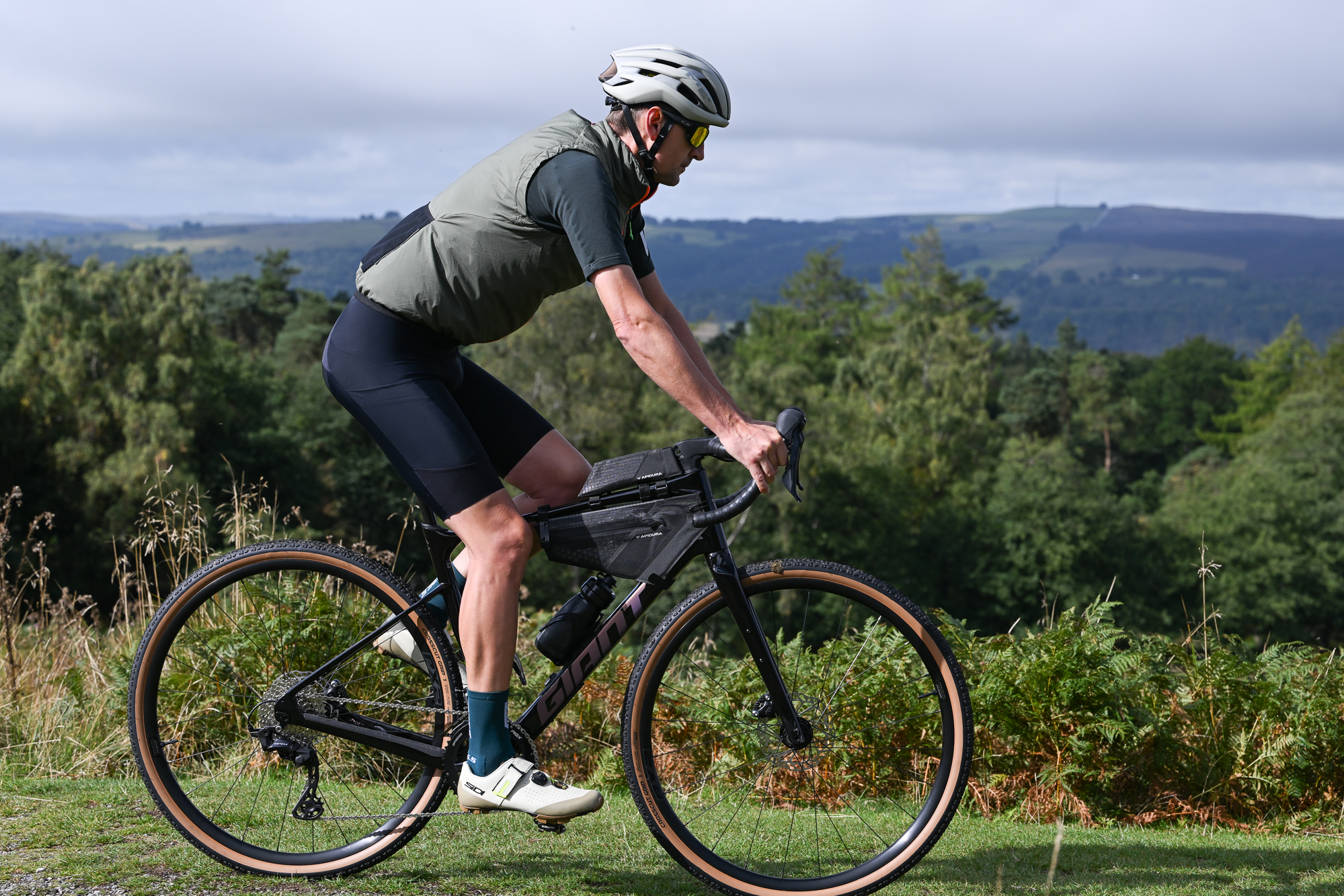
The bags make a good alternative to a saddle bag
(Image credit: Andy Jones)
However, I dislike saggy, wobbly bags, and the Apidura Aero System is remarkably stable and neat-looking, making it a pleasure to use.
Good value? Probably not for the majority of us if looked at objectively, but desirable? Sure. And who doesn’t like a few extra watts, too?
